

James Wong
2025 Kia EV5 Earth AWD review
4 Days Ago
The Skoda Kodiaq is a refreshingly European take on the medium-to-large three-row crossover, and it genuinely has some clever features.



Quickly see how this car stacks up against its competition. Select any benchmark to see more details.
Where expert car reviews meet expert car buying – CarExpert gives you trusted advice, personalised service and real savings on your next new car.
Skoda is marketed as the Volkswagen Group’s value brand. That doesn’t mean it offers bargain-basement pricing, but rather that it offers niceties like additional convenience features and nationwide drive-away pricing over a comparable Volkswagen.
Part of Skoda’s modus operandi is also to offer more space than the Volkswagen products with which Skodas share platforms.
The Skoda Kodiaq, which shares its underpinnings with the Volkswagen Tiguan, comes standard with seven seats in Australia and is slightly taller and wider than even the seven-seat Tiguan Allspace.

It’s enough for the Federal Chamber of Automotive Industries to classify the Kodiaq (and Tiguan Allspace) as a large SUV in its monthly VFACTS reports, despite the Kodiaq typically being considered as a mid-sized SUV in its home market.
Per this industry definition, Skoda’s largest SUV is in the same segment as the larger Hyundai Santa Fe and Kia Sorento, and therefore a segment above seven-seat mid-sizers like the Honda CR-V, Mitsubishi Outlander and Nissan X-Trail.
In reality, it isn’t quite that clear-cut. The Kodiaq is closer in size externally to the Outlander and X-Trail, but its pricing is closer to the Santa Fe and Sorento. And its range consists entirely of turbocharged petrol models with all-wheel drive, out of step with its aforementioned rivals.
The Kodiaq is a compelling package, but just what is it a compelling alternative to?

The Kodiaq range opens at $52,990 drive-away in base Style guise, with our Sportline tester priced from $57,990 drive-away. The flagship RS a big step up at $74,990 drive-away.
Even the priciest Mitsubishi Outlander, the all-wheel drive Exceed Tourer, is $51,490 before on-road costs; the cheaper, less well-equipped, and front-wheel drive-only seven-seat CR-V and X-Trail are cheaper still.
The Kodiaq Sportline lines up with the one-up from base Santa Fe Active and Sorento Sport in equivalent AWD guise, though the Koreans only offer all-paw traction with diesel power.
Likewise the Mazda CX-8 Touring AWD is diesel-fired ($54,090), while the larger CX-9 is closest in price to the Skoda in entry-level Sport AWD trim ($50,250). The related Volkswagen Tiguan Allspace is about to launch with a freshly facelifted range, with the 132TSI Life 4Motion priced from $48,590 plus on-roads – it’s worth noting that the Tiguan Allspace is sourced from Mexico while the Kodiaq hails from the Czech Republic, the latter incurring import tarrifs.
Our Kodiaq Sportline tester came with optional premium paint ($770), a panoramic roof ($1900), ventilated leather seats ($1900), Tech Pack ($2900) and Luxury Pack ($3700). Our tester therefore rang up at a steep $69,160. That’s $170 more than the drive-away price of a Kia Sorento GT-Line Diesel AWD.

Skoda’s tagline is Simply Clever, and there are plenty of touches that live up to that ideal. For example, there’s an umbrella easily accessible from within the driver door card, while lower down on the door is a little rubbish bin.
Door edge protectors also prevent you from nicking the door against your garage wall should you open it too far. The USB-C outlets in the cabin are also illuminated, something so simple it makes you wonder why many other brands don’t offer this.
Like some utes, there are also two separate glove compartments; the lower of these two is air-conditioned. Even the presence of lock/unlock pads on each doors is a neat touch that a lot of mainstream brands don’t bother with, while under the boot floor is a compartment inside which you can easily stow the cargo blind.


A typical Volkswagen Group touch is the presence of a felt lining in the door pockets, along with a centre console armrest that can be raised. You can also pull the latter forward to cover much of the centre console.
The dashboard layout was essentially unchanged with the Kodiaq’s mid-life update. While that means the design looks a bit dated, with the passenger-side bearing a strong resemblance to that of the outgoing Ford Everest and Ranger, it also means the Kodiaq doesn’t have one of those tablet-style infotainment screens that so often look like an afterthought.
Instead, the 9.2-inch touchscreen is positioned within the centre stack and yet remains easy to see and reach. It runs the brand’s latest interface, with over-the-air updates, wireless smartphone mirroring, and attractive navigation graphics.

There are handy shortcut menu and volume buttons to the left of the screen, while there’s a helpful bar across the top of the screen advising what drive mode you have selected, whether your phone is charging, and what the outside temperature is.
Smartphone mirroring worked reliably well, and we appreciate that Skoda hasn’t gone over to the dark side by adopting touchscreen-based climate controls. The (partial) exception is the heated and ventilated front seats – you press a physical button to activate them, but you adjust the settings via the touchscreen.
The instrument cluster is slick. While the graphics could date, the cluster is eminently adjustable with multiple different views – I personally preferred to have analogue-look gauges, with a map in the middle.
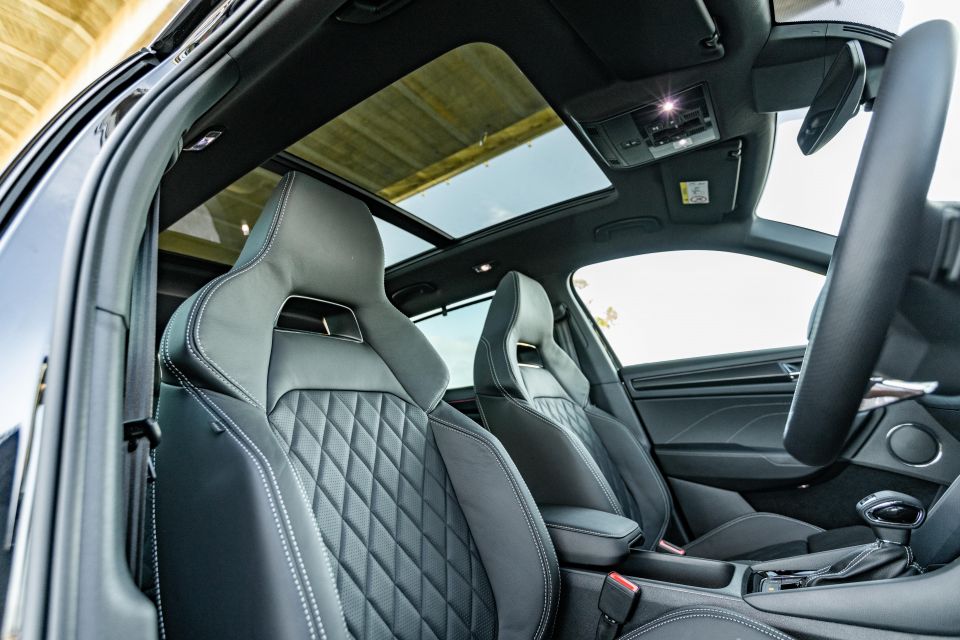

I tend to prefer steering wheel buttons for cruise control rather than a stalk, but the Skoda’s is well-placed and intuitive to use.
Material quality is hard to fault, with the dashboard and doors swathed in soft-touch plastic. While there’s no leatherette wrapping to the sides of the centre console, you’ll find soft-touch plastic there.
There are attractive stitching details throughout, though the leatherette-look inserts on the door cards aren’t as padded as they appear.
Ambience is further aided by the use of colourful lighting throughout the cabin, which changes depending on your drive mode: red for Normal, Sport and Custom, Green for Eco, and Blue for Comfort and Snow.

The sports seats of the Sportline are impressive-looking, but they look like Skoda is trying too hard and I found them much too firm.
Step into the second row and there’s ample room in every dimension. While there is a fairly high driveline hump the middle seat occupant has to straddle, it’s at least quite narrow. At 180cm tall, I could sit in the middle seat and my head wouldn’t touch the panoramic roof.
Unusually, there are no USB outlets. There are, however, 12V outlets in both the second and third rows, along with 1L bottle holders in the rear doors and map pockets on the front seatbacks.
There are also air vents at the rear of the centre console, along with controls for the third zone of climate.


You can fit child seats in the second row using one of the three top-tether or two ISOFIX anchor points.
The third row is best suited for small children, and it’s awkward clambering back there. Once back there, it’s more comfortable than, say, a CR-V, but it’s not as comfortable as a Santa Fe or Sorento.
My young nephew wasn’t enamoured with the third row, citing the lack of toe room and the strange two-piece belts.
You can make it more hospitable by sliding the second row forward, while the second row can be dropped via a remote release in the luggage area.

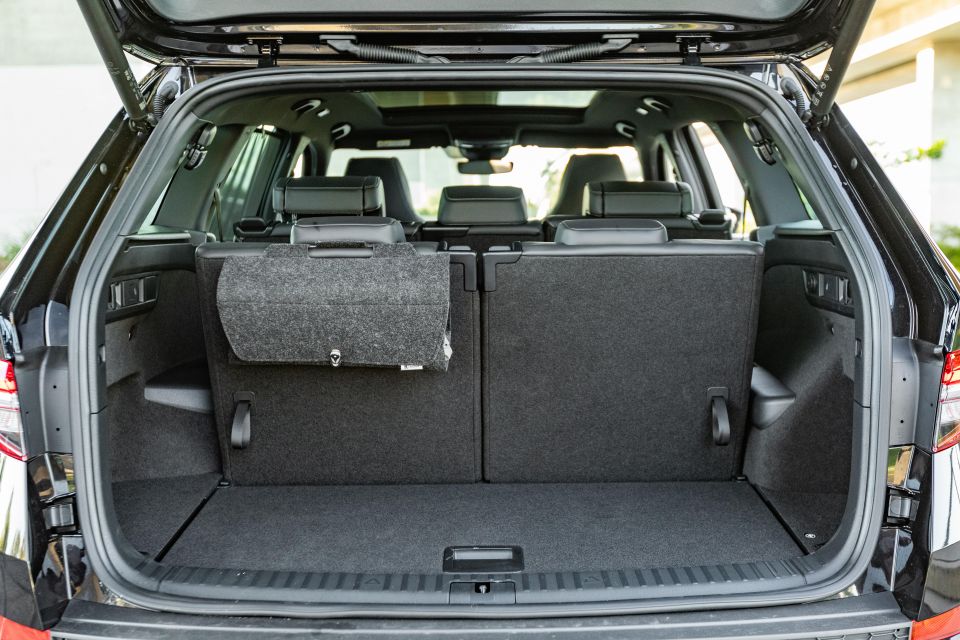

There’s 270L of luggage space behind the third row, measured up to the headrests. Fold the third row and there’s 630L up to the rear shelf, and then 2005L up to the roof with the second and third rows folded.
The interior is mostly impressive, but there were a few demerits to note. The lack of USB outlets in the rear is odd, and while the rear doors are light and easy to open for children, they often require a firmer slam to shut.
The camera display on the touchscreen is also a bit washed-out.
While we appreciated the reprieve from piano black trim, the brushed metal-look cover for the wireless charging pad was already quite scuffed on this new test car.
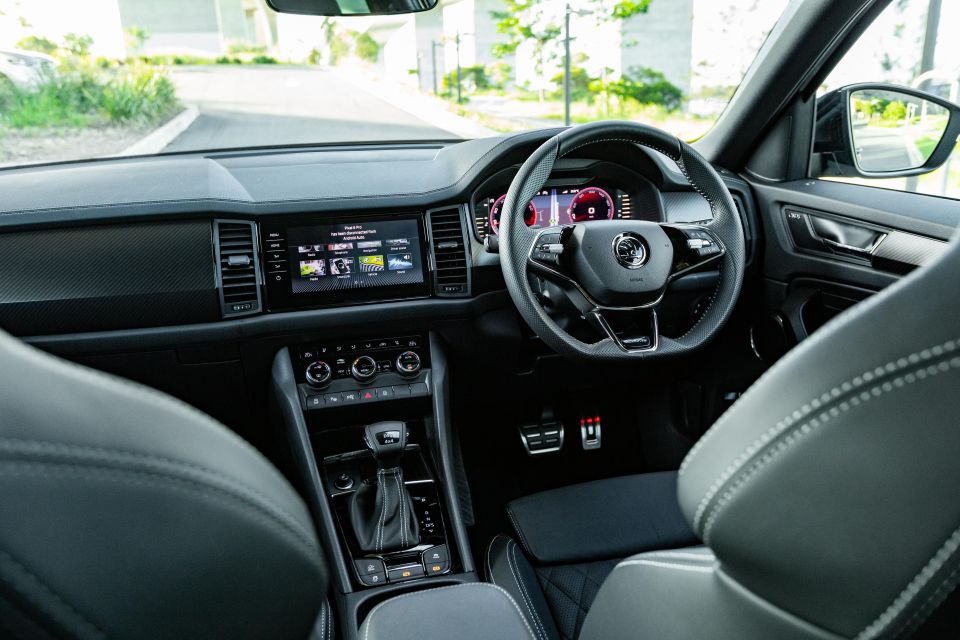
The wireless phone charger also seemed temperamental, as my phone would stop and start charging again even when it wasn’t moved.
Some of these charging glitches could be the result of my phone or case, but it’s worth noting to those who haven’t used wireless smartphone mirroring and wireless chargers that the former will often chew your battery and the latter can be quite slow at restoring it.
Overall, this is a neatly-presented, well-assembled interior, even if the design is arguably showing its age.
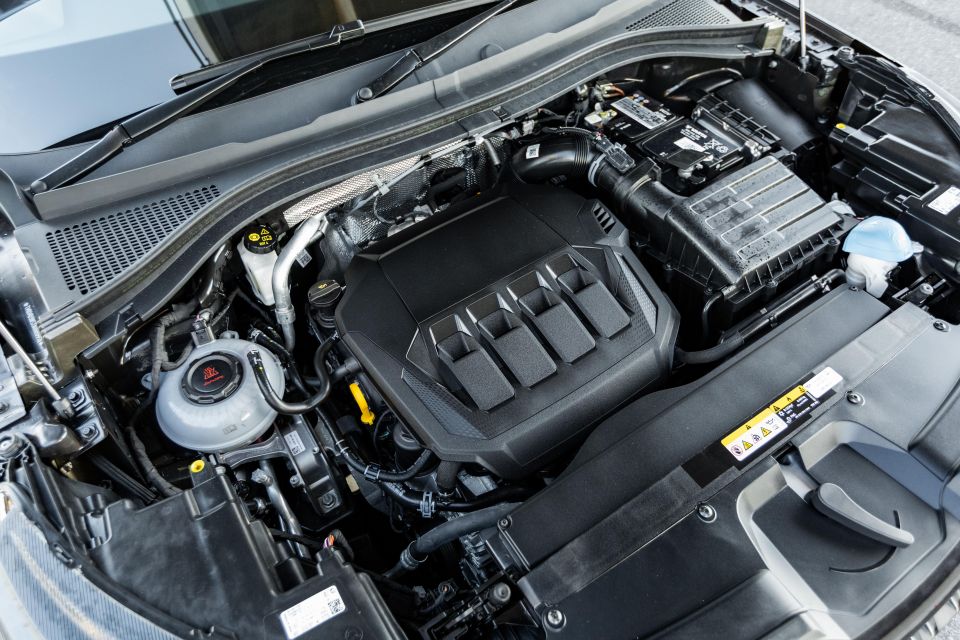
The Kodiaq Sportline, like the base Style, is powered by a 2.0-litre turbocharged four-cylinder petrol engine making 132kW between 3900 and 6000rpm and 320Nm between 1400 and 3940rpm.
It’s mated with a seven-speed dual-clutch transmission and all-wheel drive.
The presence of a turbocharged four-cylinder petrol engine in this part of the market is somewhat unusual. The Nissan X-Trail and Mitsubishi Outlander use naturally-aspirated four-cylinder engines, though the smaller Honda CR-V has a 140kW/240Nm 1.5-litre turbo.

Other so-called Large SUVs with seven seats also go without turbo-petrol power, offering a choice of naturally-aspirated petrol or turbo-diesel fours (Mazda CX-8) or a choice of a petrol V6 or a turbo-diesel four (Santa Fe, Sorento). That is, unless you go for the Skoda’s Tiguan Allspace corporate cousin or the much larger Mazda CX-9.
Over a loop comprising inner-city, suburban and highway driving, we averaged 8.6L/100km. Skoda claims a combined cycle fuel economy rating of 8.2L/100km, while our observed fuel economy increased to 10.2L/100km over the course of a week.
It requires 95 RON premium unleaded fuel.

Where expert car reviews meet expert car buying – CarExpert gives you trusted advice, personalised service and real savings on your next new car.
There’s a rather sporty feel to the way the Kodiaq Sportline drives, appropriately enough.
Even in its Normal drive mode, there’s a firmness to the Kodiaq’s ride. We’re not sure a family SUV needs to feel quite so firm, however it stops short of feeling busy and there’s a polished feel to the way it absorbs impacts. Only rarely will a sharp impact jolt the car, and this is typically over larger road scars.
In this drive mode, the Kodiaq is also quite comfortable and composed over unsealed roads. While you have a range of drive modes to choose from (Snow, Off-Road, Comfort, Custom, Sport, Eco), Normal strikes the right balance.
Sport, for example, makes the ride feel a bit fidgety, holds onto gears for longer, and adds too much heft to the steering. And then there’s Comfort, which dials in a bit of float to the suspension, and makes the car feel somewhat ponderous.

Custom mode allows you to tailor the chassis, steering and throttle settings, among others.
Stick with Normal, and you get nicely-weighted steering, well-resolved damping, and capable handling. The Kodiaq stays nice and flat in bends with little body roll, and there’s good grip going into corners.
The Kodiaq’s all-wheel drive system uses an electronically-controlled multi-plate clutch and defaults to front-wheel drive, with the rear axle only engaged if necessary.
On a slippery road it can evenly apportion drive torque across all four wheels, while if conditions worsen up to 90 per cent of the drive torque can be sent to the rear axle.
The Kodiaq felt composed in rainy weather, but on a dry road it’s possible to chirp the tyres when turning from a stop. In some driving on unsealed roads we found the system to feel a little reactive, but this is mitigated through the use of the dedicated Off-Road drive mode.

This tweaks the settings of systems like the stability control and anti-lock brakes, though Skoda says in the owner’s manual that even with it switched on “your vehicle is never a true SUV”.
There’s a grown-up feel to the way the Kodiaq drives, particularly the way it suppresses noise. The cabin remains quite isolated from wind and tyre noise, even at high speeds or on coarser-chip roads.
Engine noise won’t perturb cabin occupants either – the four-cylinder engine isn’t particularly vocal, and the soundtrack it does produce is inoffensive and vaguely sporty.
The Kodiaq’s powertrain has some pleasant low-end grunt but it doesn’t have the same sense of urgency as some smaller SUVs like the turbocharged Mazda CX-5 or Ford Escape, or the Volkswagen Tiguan with its more potent 162TSI powertrain.
As we’ve found with many turbocharged engine/dual-clutch auto pairings, there’s a slight hesitation off the line. Despite this, the Kodiaq never feels sluggish around town.

Another dual-clutch hiccup is the slight jittery feel at low speeds, particularly when creeping through heavy traffic, but it’s not objectionable in the Skoda.
The Tiguan’s 162TSI powertrain would be most welcome in the Kodiaq as a more affordable alternative to the flagship RS, but the 132TSI isn’t underpowered. Skoda actually makes an even less powerful 110kW 1.5-litre engine available in Europe.
The lane assist on highways does a good job of keeping you within your lane, though it sometimes makes the steering feel a bit loose. Otherwise, the Kodiaq’s driver assist systems work well.
We also appreciate the powerful Matrix LED headlights and the presence of an Auto Hold function that will stay on, even if you turn the car off and on again. My only gripe was the pedal placement, which seemed ever so slightly askew to me and seemed to put my feet at a different angle.




Kodiaq Sportline higlights:
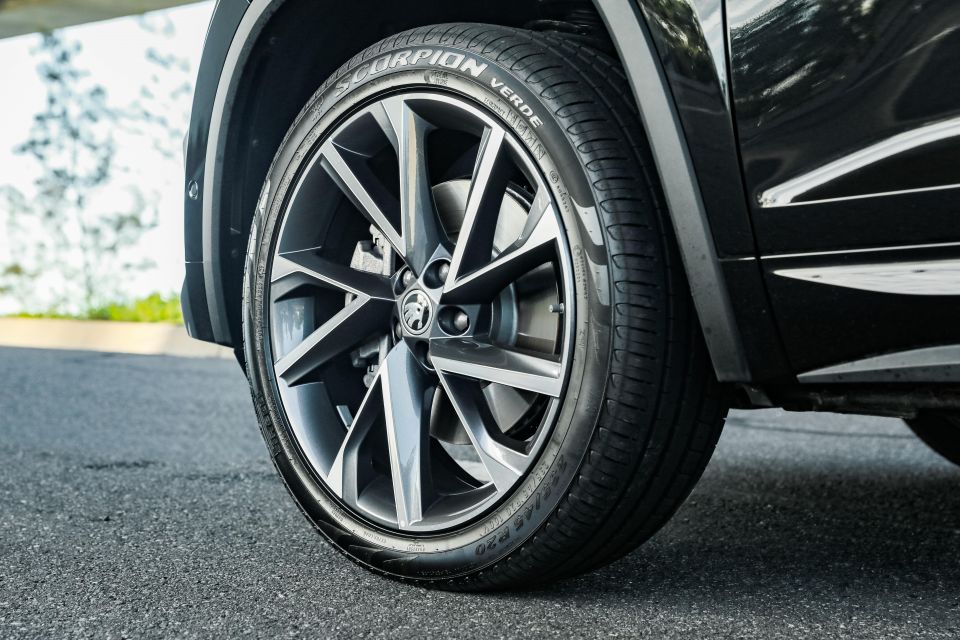

That’s over features from the base Style:


Our tester came with almost every available option, however many of these extra features are temporarily unavailable due to semiconductor chip shortages.
A Skoda Australia spokesperson recently confirmed the Kodiaq will only be in de-specified form for “a few months”, and the company has been crediting affected customers.
We’ve marked affected features with an asterisk below, and we recommend if you’re looking at a Kodiaq to check out the Skoda website or contact a dealer.
The Tech Pack ($2900) adds:

The Luxury Pack $3700 adds:
Our tester also included a panoramic sunroof ($1900) and ventilated leather seats ($1900), while other standalone options include a tow bar ($2300) and side steps ($1400).
Bundling blind-spot monitoring, lane-keep assist and rear cross-traffic alert in a costly Luxury Pack is a frustrating choice. These are standard on most rivals, including the Tiguan 132TSI Life.

The Skoda Kodiaq has a five-star ANCAP safety rating based on testing conducted in 2017.
It received an adult occupant protection score of 92 per cent, a child occupant protection score of 77 per cent, a pedestrian protection score of 62 per cent and a safety assist score of 54 per cent.
Standard safety features include:
As mentioned above, numerous active safety and driver assist features are bundled into option packages.

The Kodiaq is covered by a five-year, unlimited-kilometre warranty.
It requires servicing every 12 months or 15,000 kilometres, and Skoda offers pre-paid service plans.
A five-year/75,000km pack costs $1800, while the seven-year/105,000km pack costs $2700.
The five-year pack is cheaper than the Tiguan Allspace 132TSI’s ($2950), while the Kodiaq is cheaper to service over five years than a Santa Fe ($1995-2295) or Sorento ($2388-2393). A Mazda CX-8 costs between $1745-1890 over five years, while a Mitsubishi Outlander costs just $995.

The Kodiaq feels more special than something like an Outlander or Santa Fe, with a slick European look and feel.
The Sportline’s extra $5000 over the base Style adds a range of appealing mechanical and aesthetic changes, but the Kodiaq starts getting pricey as you tick the option boxes. Some of the features in the $3700 Luxury Pack, such as blind-spot monitoring and lane-keep assist, ought to be standard.
It’s also hard to avoid the fact a fully-loaded Kodiaq Sportline like our tester is roughly the same price as a top-spec Sorento GT-Line. The Kodiaq may have some noteworthy features like adaptive suspension and semi-autonomous parking assist, but the Sorento has more cabin space plus better fuel economy courtesy of the available turbo-diesel and petrol-electric hybrid powertrains.

But the Kodiaq does fit into its own little niche among similarly-priced medium and large SUVs. There are more luxury and convenience features than a Tiguan Allspace with the same engine, if less in the way of standard safety equipment.
There’s also a combination of a turbo-petrol engine and a third row of seats that’s hard to find in this part of the market, Tiguan Allspace and CX-9 aside.
Unless you really love the look of the Sportline – and we admit it is a looker – it arguably makes more sense to go with the base Style, to which you can still add the optional Tech and Luxury packs.
Whether you’re buying a Style or Sportline, you’re getting a neatly-presented, dynamically-poised SUV full of clever touches and boasting a comfortable second row of seating. But don’t go believing this is a large SUV because of some industry classification, and remember Skoda is no longer a budget brand.

Click the images for the full gallery
MORE: Everything Skoda Kodiaq
Where expert car reviews meet expert car buying – CarExpert gives you trusted advice, personalised service and real savings on your next new car.
William Stopford is an automotive journalist based in Brisbane, Australia. William is a Business/Journalism graduate from the Queensland University of Technology who loves to travel, briefly lived in the US, and has a particular interest in the American car industry.


James Wong
4 Days Ago


Angus MacKenzie
3 Days Ago


Paul Maric
2 Days Ago


Max Davies
2 Days Ago


James Wong
1 Day Ago


William Stopford
19 Hours Ago